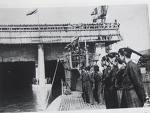|
German`s submarine shelters at Brittany costs
 On June 21, 1940, France signed away national sovereignty to Germany. Germany would occupy more than half of the country, including the strategic Atlantic naval bases of Brest, Lorient, St. Nazaire, La Pallice and Bordeaux, France was forced to allow the Kriegsmarine to base its feared U-boat flotillas on the Bay of Biscay. On June 21, 1940, France signed away national sovereignty to Germany. Germany would occupy more than half of the country, including the strategic Atlantic naval bases of Brest, Lorient, St. Nazaire, La Pallice and Bordeaux, France was forced to allow the Kriegsmarine to base its feared U-boat flotillas on the Bay of Biscay.
Less than 48 hours after the French armistice, a long train left U-boat headquarters in Wilhelmshaven, destination: Lorient, on the remote and rocky Brittany coast. In addition to torpedoes, radios, navigation and optical instruments, spare parts, food and drink, the train accommodated the small personal staff of 49-year-old Commander-in-Chief U-boats – newly promoted Vizeadmiral Karl Dönitz. The admiral’s mission; transform the Biscay ports into impregnable bastions, and expand the sea war of attrition deep into the Atlantic from bases now 450 miles nearer the Western Approaches dense shipping lanes. Little more than a year later, in September 1941, a quarter of the entire British merchant fleet lay on the ocean floor.
 Dönitz headquartered his command in a requisitioned château at Kerneval on the Scorff River roadstead, within view of the developing bunker base. Finished in a record time of only 23 months and working around the clock concrete mixers in the hundreds and trucks by the thousands poured concrete. Dönitz headquartered his command in a requisitioned château at Kerneval on the Scorff River roadstead, within view of the developing bunker base. Finished in a record time of only 23 months and working around the clock concrete mixers in the hundreds and trucks by the thousands poured concrete.
Construction raced ahead as the five Biscay bases swallowed 14 million cubic feet of concrete and one million tons of steel. By mid -1942, the Allied Bomber Command had fully awakened to the threat the bases posed. It was too late; although construction was interrupted, it never stopped. The Germans recorded at least 300 air raids on Lorient alone by the US Eighth Air Force and British Bomber Command. Not one mission succeeded in putting the pens out of commission.
 Much more than fortified U-boat enclosures, the pens were more like complete naval bases under concrete. Feeding the unquenchable needs of repair and overhaul facilities, underground pipes delivered oil, gasoline, lubricants, fresh water and seawater. All the necessities and many of the conveniences equivalent to a medium-sized town lay behind solid 11 foot-thick reinforced concrete external walls and three-foot deep armored double blast doors. Extending hundreds of feet within the immense interiors were complete steam and electric generating stations, air-raid shelters, 1,000 man-capacity crew dormitories, cold storage and food lockers, mess facilities, and scores of drafting and engineering offices. Other spaces contained fire-fighting, repair, and first aid stations, supply and storage rooms, kitchens, bakeries, and hospital and dental facilities. Separate bunkers housed electrical transformers, fuel tanks, and stand-by power generators. Dangerous or delicate stores such as torpedoes, ammunition, and optical equipment went to fortified bunkers in town. Much more than fortified U-boat enclosures, the pens were more like complete naval bases under concrete. Feeding the unquenchable needs of repair and overhaul facilities, underground pipes delivered oil, gasoline, lubricants, fresh water and seawater. All the necessities and many of the conveniences equivalent to a medium-sized town lay behind solid 11 foot-thick reinforced concrete external walls and three-foot deep armored double blast doors. Extending hundreds of feet within the immense interiors were complete steam and electric generating stations, air-raid shelters, 1,000 man-capacity crew dormitories, cold storage and food lockers, mess facilities, and scores of drafting and engineering offices. Other spaces contained fire-fighting, repair, and first aid stations, supply and storage rooms, kitchens, bakeries, and hospital and dental facilities. Separate bunkers housed electrical transformers, fuel tanks, and stand-by power generators. Dangerous or delicate stores such as torpedoes, ammunition, and optical equipment went to fortified bunkers in town.
|